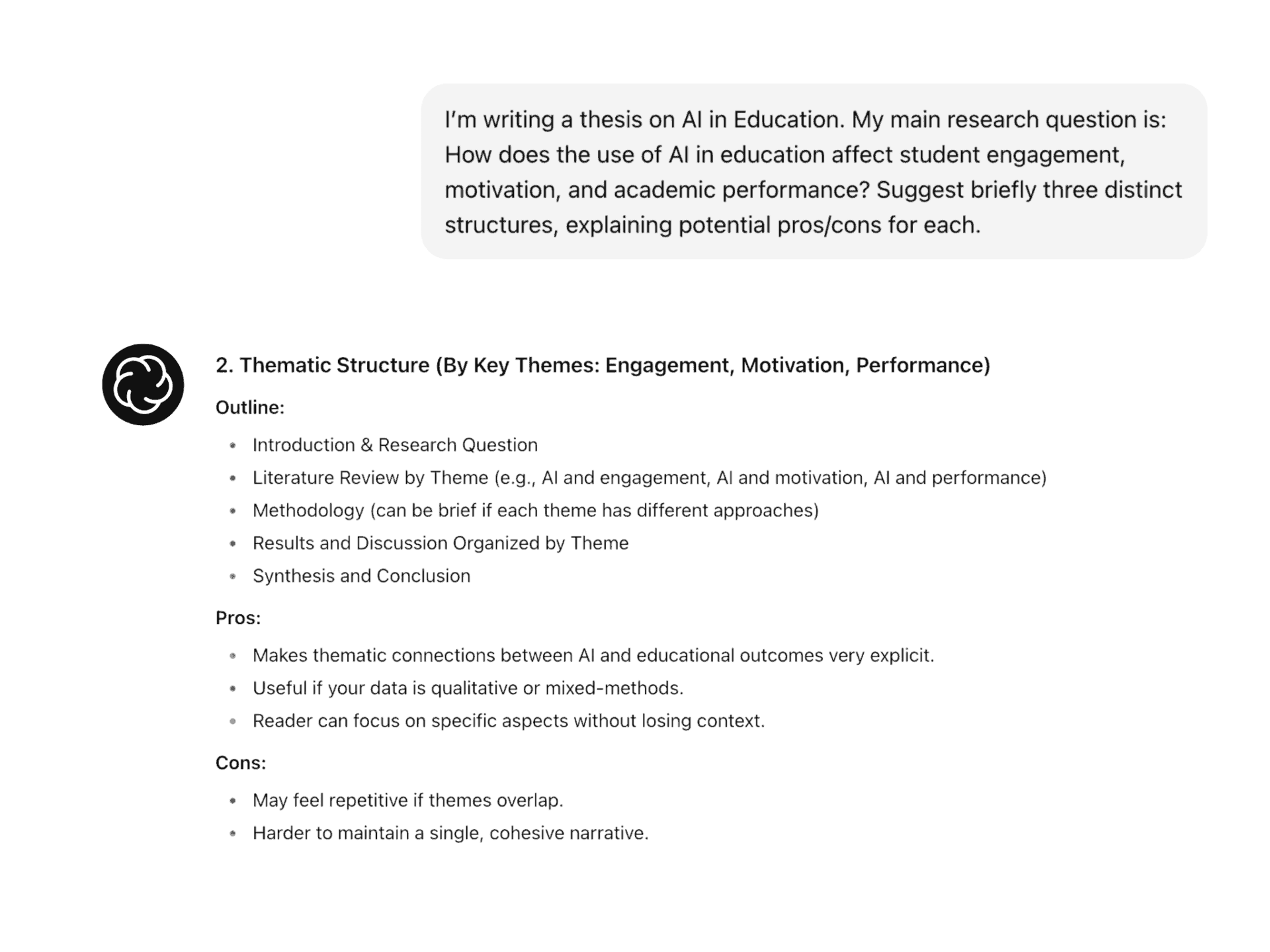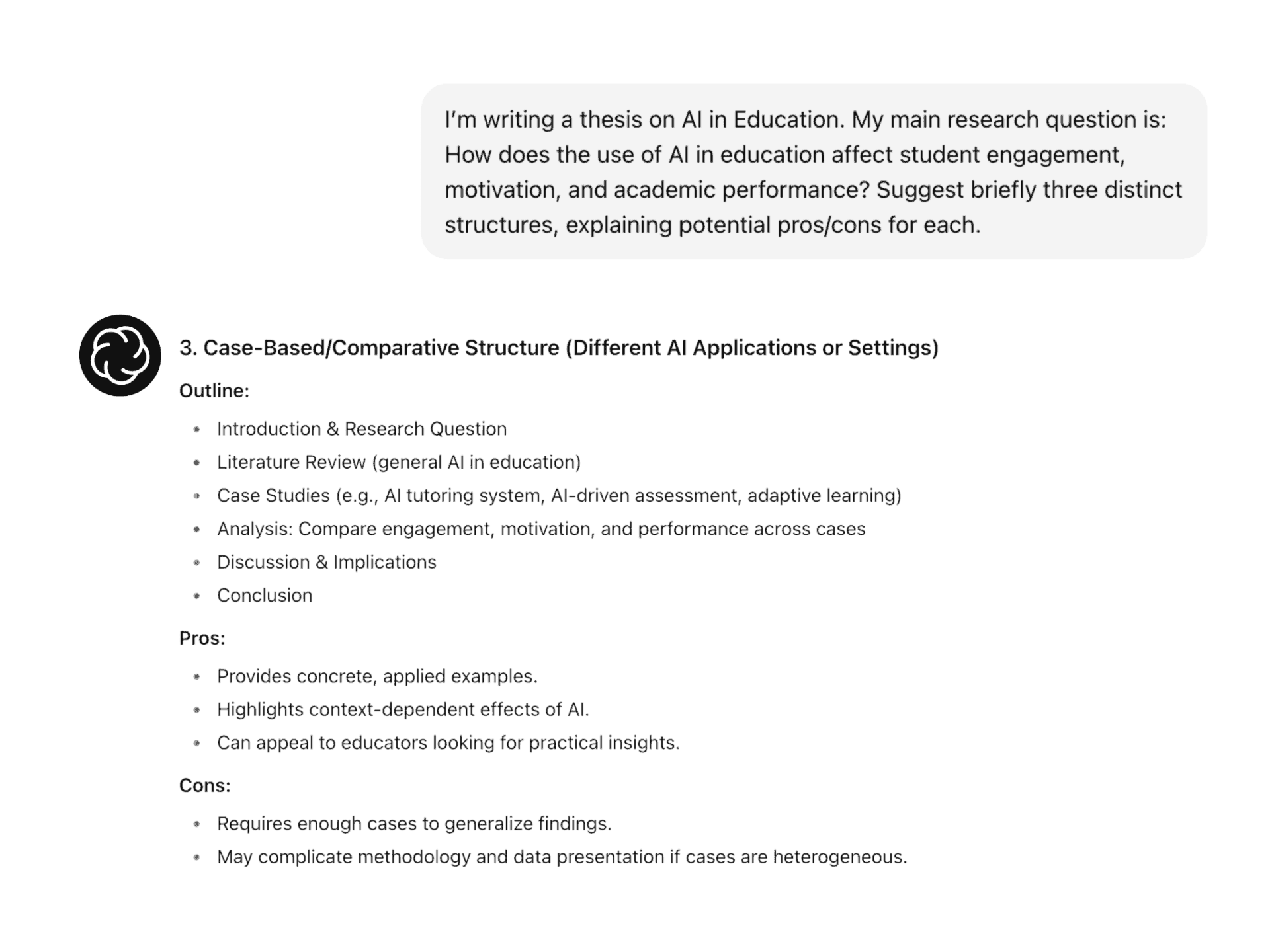Key Takeaways: Use ChatGPT strategically as a brainstorming and thinking partner to structure your thesis. Our three-step approach, Plan–Test–Perfect, helps you organise your work efficiently with AI support, while keeping the core intellectual effort firmly in your hands.
Table of Contents
Introduction
Most students waste hours struggling with thesis structure, or worse, trust ChatGPT to do it for them, and end up with something generic and unusable. Let’s be honest: thesis structure is challenging. It requires a clear logical structure, field-specific conventions, and careful argumentation. Our approach, Plan–Test–Perfect, leverages AI’s strengths while mitigating its weaknesses. It’s practical, systematic, and adaptable across disciplines.
However, it should be noted that AI cannot replace your judgment, but it can serve as a structured brainstorming and organisation tool. That’s why we also offer expert thesis support services to help you refine your structure and get personalised guidance. In this article, we talk specifically about ChatGPT, since it is the most widely accessible and effective tool for this kind of structured thesis support.

Why Random ChatGPT Inputs and Prompts Often Fail
Random AI prompts or ChatGPT inputs are often not goal-oriented. Many students use ChatGPT without a proper structure and plan, asking questions in isolation and expecting ready-made solutions. Research shows that structured planning and iterative evaluation are essential for effective academic writing (e.g., Tlili et al., 2023). Good writers spend much more time planning than writing.
Our system introduces intentional checkpoints, ensuring that AI supports, but does not replace, your critical thinking. Furthermore, Swiss universities are world-leading when it comes to research. Students should be able to use these tools to help them think and write, not think or write for them. Our approach ensures exactly that.
Our research and testing at Delta Lektorat show that the biggest problems with random ChatGPT prompting for academic writing mainly stem from the following points:
- Lack of systematic evaluation of AI-suggested structures.
- Generic responses that ignore field-specific conventions.
- No iterative process, even though a convincing structure requires step-by-step refinement.
- No quality control to detect logical gaps or argumentative weaknesses from the AI.
Without a clearly structured approach, you waste time on unfocused suggestions and risk a weak line of argumentation. That’s why we recommend the Plan–Test–Perfect method: it uses the strengths of AI to improve the organisation and clarity of your work, while keeping your critical thinking and academic judgment at the centre.

Reality Check: What ChatGPT Can and Can’t Do
Let’s do a reality check before diving into the mystery of your main thesis with ChatGPT. For this test, we ran 600 iterations using different prompts and had the results evaluated by our experienced editors. A clear pattern emerged: ChatGPT excels at mechanical tasks and creative brainstorming, but often falls short when it comes to nuanced judgment, subject-specific precision, and context-sensitive depth. To make these differences tangible, we have created a concise table comparing the strengths and limitations of ChatGPT in academic writing.
Please note that these observations are based on our practical experience and are not absolute; rather, they reflect patterns we have repeatedly seen in our tests and in practice. You can use this chart as a practical guide to understand what ChatGPT handles well and where it may fall short.

Phase A: Plan – ChatGPT-Assisted Brainstorming
Instead of expecting ChatGPT to create your perfect structure, start by asking it for multiple structural approaches.
Example prompt: “I am writing a thesis on [topic]. My overarching research question is [question]. Suggest three different structures and explain the possible advantages and disadvantages of each structure.”
Below is an example showing how ChatGPT can support you in this process. In this example, three structure suggestions are provided—a deliberate approach to make different lines of thinking and argumentation visible. This allows you to compare which option best fits your research question and to combine the strongest elements, rather than relying on a single AI-generated answer.
Please note that the original article was written in English, so the screenshots show an English interface. However, the concepts and steps presented are universally applicable and can easily be adapted to your preferred language.



This is how you can make the most of the results:
- Evaluate multiple options critically.
- Identify what makes sense for your argument.
- Ask follow-up questions to clarify chapter goals and flow.
Then dig deeper: “For the [structure option you prefer], what questions should each chapter answer? What would be the logical flow of arguments?”
Reality check: ChatGPT’s suggestions are rather basic, but they help you express more clearly what you want to achieve in each section or chapter. It shows you what should be included, but you need to develop the full picture and further refine the ideas yourself.
Phase B: Test – Structured Self-Evaluation
This phase is what makes the difference between generic ChatGPT outlines and a thesis structure that works for your argument. Instead of just accepting its draft outline, you deliberately test it against your own research needs. Think of it as stress-testing your foundation before building the house.

How to test it effectively:
- Logic: Are the chapters clearly connected? Ask yourself: “Does this chapter directly contribute to answering my research question?”
- Flow: Does the order of the content align with your research questions? Ask yourself: “Does my argument develop naturally and coherently from chapter to chapter?”
- Balance: Are the theoretical background and results proportionate to your argument? Ask yourself: “Do theory and results complement each other meaningfully, or does one dominate the other?”
- Fit: Does the proposed structure conform to the norms of your field? Ask yourself: “Does my structure reflect the expectations and conventions of my discipline?”
- Clarity: Can an outsider easily follow the development of your argument? Ask yourself: “Would someone without prior knowledge understand how I arrived at my conclusions?”
Example:
- Random Chat GPT output: “Introduction, Literature Review, Methodology, Results, Discussion, Conclusion.”
- Plan–Test–Perfect method: You realise that your literature review covers broad theory, while your research question is narrow. You adjust the chapter focus and add connecting sections to guide the reader.
As for the result, instead of relying on its random structure, with better testing, you will need to refine it into something that makes sense for your specific thesis and discipline. This part is where real academic value emerges. A well-tested structure also sets you up for Phase C, where ChatGPT can help with routine tasks and templates without compromising your argument.
Phase C: Perfect – Practical Implementation
Once your tested structure feels solid, it’s time to let ChatGPT save you hours of routine work. This phase is about execution, not big-picture design. Tasks where it shines in this phase:
- Templates: Prompt: “What’s a typical breakdown of a literature review in [my field]? Create a draft structure I can adapt.”
- Transitions: Prompt: “Suggest five different ways to transition from [topic A] to [topic B] in an academic tone.”
- Checklists: Prompt: “For a methodology section, list the exact questions I need to answer about each method used.”
- Micro-structure: Prompt: “Give me three possible subheadings for my findings chapter based on these themes: [theme list].”
At this stage, you already know your thesis flow. You move on focusing on critical thinking, while ChatGPT has cleared the path of mechanical tasks, making the writing process faster and smoother without sacrificing quality. This phase completes the Plan–Test–Perfect cycle, turning your tested structure into a fully actionable writing plan.

Conclusion
The higher education landscape is changing rapidly. Students who master the AI-supported structuring process can significantly shape their academic success in the digital age. You know: AI cannot write your thesis structure for you. However, we have shown that by using our Plan–Test–Perfect method, it can become a valuable brainstorming partner, one that helps you tackle organisational and content-related challenges more systematically, while keeping your critical thinking and scholarly originality at the forefront.
Our editors come from the same country as your university or college, whether Switzerland, Germany, or Austria, and are intimately familiar with the academic requirements, linguistic nuances, and evaluation standards of your institution. They know what supervisors truly pay attention to and can help refine your work so that it not only meets formal standards but also excels in content and style.
Need help refining your thesis? Explore our services at Delta Lektorat here.
Curious about other AI tools that can help with your thesis writing? We’ve got you covered! Read our article on 7 Game-Changing AI Tools.
Frequently Asked Questions (FAQs)
AI can create drafts and perform functional validations, but it cannot replace your knowledge of your research field. Use it as a supportive thinking partner, not as a substitute for your own understanding, analysis, and judgment. You remain responsible for your work.
Be specific. Formulate a clear prompt in ChatGPT: “Suggest three thesis structures for [topic], including advantages and disadvantages.” Always critically evaluate the results.
Generally, yes, if you use AI transparently and the substantive work clearly comes from you. Still, always check your university’s specific guidelines.
We provide editing and proofreading services, as well as coaching and personalised support to help you turn your draft into a strong, discipline-appropriate thesis. You can check all our services here.
Disclosure: This article was prepared by human contributors. Generative AI tools were used to support brainstorming, language refinement, and structural editing. All final decisions regarding content, recommendations, and academic insights reflect human judgment and expertise.
References
Tlili, A., Shehata, B., Adarkwah, M. A., Bozkurt, A., Hickey, D. T., Huang, R., & Agyemang, B. (2023). What if the devil is my guardian angel: ChatGPT as a case study of using chatbots in education. Smart Learning Environments, 10, Article 15. https://doi.org/10.1186/s40561-023-00237-x
Flinders University. (2022). Planning and outlining. Flinders University Student Learning Support Service. https://students.flinders.edu.au/content/dam/student/slss/academic-writing/planning-and-outlining.pdf
Huber, S. (2025, May 14). Secure and trustworthy development of AI in Switzerland. Swisscom. https://www.swisscom.ch/en/about/news/2025/05/14-vertrauenswuerdige-ki-entwicklung.html
Dea is a senior researcher passionate about helping students navigate the world of academia. She explores the intersection of AI and scholarly work, offering insights on how technology can enhance writing, research, and learning. As the Head of Partnerships at Delta Lektorat, Dea leads collaborations with universities and student associations to promote excellence in academic writing and innovative approaches to thesis support. Her work focuses on bridging traditional academic rigour with emerging digital tools that empower students and scholars alike.



